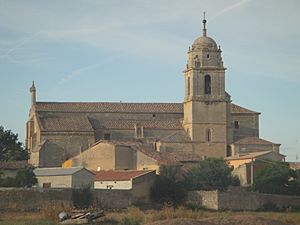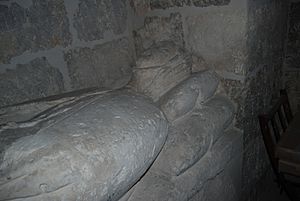Church of Nuestra Señora del Manzano, Castrojeriz facts for kids
Quick facts for kids Iglesia de Nuestra Señora del Manzano |
|
|---|---|
 |
|
| Religion | |
| Affiliation | Roman Catholic |
| District | Castrojeriz |
| Province | Province of Burgos |
| Ecclesiastical or organizational status | Temple |
| Location | |
| Location | Spain |
| Architecture | |
| Architectural type | Church |
| Architectural style | Gothic, Renaissance, Romanesque |
| Completed | 1214 |
The Church of Nuestra Señora del Manzano (which means "Our Lady of the Apple Tree") is a Catholic church in the town of Castrojeriz, located in the province of Burgos, Spain. This beautiful church started being built in 1214. It was Queen Berengaria of Castile who wanted it built. She was the daughter of King Alfonso VIII of Castile and the mother of King Ferdinand III of Castile. The church stands right at the bottom of the hill where the Castle of Castrojeriz is. It used to be a very important church called a collegiate church.
Contents
History of the Church
The exact beginnings of the church are not fully known. However, in the 900s, a leader named Count García Fernández gave special permission to the canons (priests) of the church. This permission, given in 974, allowed them to build houses with towers and strongholds in Castrojeriz.

The Count also gave the canons male workers from the town. He decided that the canons and other religious people in Castrojeriz should have special rights. For example, if someone spoke badly about them or caused trouble in their homes, they had to pay a large fine. If anyone hurt or killed a canon, their family would receive a large sum of money. King Fernando IV confirmed these special rights in 1299.
In 1050, King García Sánchez III of Navarre connected the church to the monastery of San Millán de la Cogolla. It was then called the Santa Maria de Castro abbey. Later, when the King of Navarre lost his lands in Castile, the church became independent for a while. Then, during the time of King Alfonso VII, it became linked to the Cathedral of Burgos. The abbot (head priest) of Castrojeriz even got a special seat in the Burgos cathedral. In 1173, during the reign of King Alfonso VIII of Castile, the church changed its rules and stopped following the Benedictine order.
Changes Over Time
In the late 1400s and early 1500s, the Manzano church was updated. Some of its arched ceilings were changed, and the round window (rosette) at the main entrance was strengthened. In the 1700s, more parts of the church were renovated. This included the main body and holy area, the tower, and the roof.
During this time, new parts were also built. These included the Chapel of the Virgen del Manzano, two sacristies (rooms where priests prepare), and a new area for the choir. A famous architect from Biscay, Juan de Sagarvinaga, helped with these projects.
In the 1700s, special church services were held to remember important kings and queens. These included King Alfonso VII, King Sancho IV of Castile and his wife Queen María de Molina, and King Ferdinand IV of Castile and his wife Queen Constance of Portugal. At that time, the church had many religious leaders, including an abbot, twelve canons, and several other priests.
Church Design and Art
Outside the Church
The main entrance of the church is in the Gothic style. It has a beautiful arched doorway with detailed carvings of plants. On each side of the entrance, there are two stone statues from the 1200s. These statues show the Virgin Mary and the Archangel Gabriel.
Above the main entrance is a large, round stained-glass window called a rose window. It shows God blessing, surrounded by the apostles. Around the edge of the window are symbols of the four writers of the Gospels and heads of angels.
The entrance on the south side of the church is in the Renaissance style. The bottom part of the church tower is Romanesque. However, the tower was updated in the 1700s, and a bell tower was added in 1746. The original back part of the church (apse) was replaced with a rectangular shape during the 1700s renovations.
Inside the Church
The church was mostly built in the Gothic style, but you can still see some Romanesque parts inside. The entire church is made of large, cut stones. It has three long sections called naves. The middle nave is about seventeen meters taller than the two side naves. The side naves end in flat walls and have ribbed arches from the late Romanesque period and Gothic stone arches.
The oldest artworks inside the church are two altarpieces (decorated screens behind the altar). One is of the Cristo crucificado (Crucified Christ) from the late 1500s. The other is of St. James the Apostle from the 1600s. Most of the other altarpieces in the church are from the 1700s.
The main altarpiece was put in place in 1760. It was paid for by the Counts of Ribadavia. This altarpiece has several paintings showing scenes like the Annunciation (when Mary was told she would have Jesus) and the Birth of Christ. The painting of the Annunciation was done by Anton Raphael Mengs. Other paintings on the altarpiece are thought to be by his students, like Mariano Salvador Maella and Francisco Bayeu.
Other important items from the 1700s inside the church include the choir stalls (special seats for the choir), a stand for reading (lectern), and a large organ in a Neoclassical style. The choir area is in the main nave and is closed off by a beautiful Renaissance gate. There is also a painting of the Virgin de las Cerezas (Virgin of the Cherries) in the choir, which is believed to be by the Flemish painter Pieter Pourbus.
Nuestra Señora del Manzano Chapel
This chapel was built in the 1700s by architect Juan de Sagarvinaga. It has three altars. The two side altars honor images from the former Monastery of San Anton Castrojeriz. The main altar in the chapel is in the Baroque style. It holds the image of Nuestra Señora del Manzano. This altar was decorated with gold by a painter named Barranco Martinez Burgos.
The image of Nuestra Señora del Manzano is a colorful stone statue. It shows the Virgin Mary standing, wearing a blue robe with stars and a cloak. She holds the Christ Child in her left arm and gently touches his foot with her right hand. The Virgin wears a crown and has a special charm on her chest with the letter "T" on it.
Several old songs, called Canticles, were written about the Virgin del Manzano. One song tells how a stone worker was saved by the Virgin when he almost fell. Another song is about a master builder who worked on the church.
Queen Eleanor of Castile's Tomb
Inside the church, near the area for baptisms, there is a Gothic-style tomb. Many people believe it holds the remains of Queen Eleanor of Castile. She was the daughter of King Ferdinand IV and the sister of King Alfonso XI. Queen Eleanor was sadly killed in 1359 in Castrojeriz.
The tomb was found in June 1970, hidden behind a wall. Experts believe it belongs to Queen Eleanor because its style matches other tombs from the mid-1300s. Also, the tomb has a carving of a woman lying down on its lid. Records from the past also mentioned that the queen was buried in this church. The tomb was moved to its current spot in the 1700s to make room for a crypt for the Counts of Castro.
Documents found seem to support the idea that Queen Eleanor was buried in this church after her death in 1359. However, two other places also claim to have her remains: the La Seu Vella Cathedral in Lleida and the Las Huelgas de Burgos monastery, where many kings and queens of Castile and León are buried.
Church Museum
Today, the church has a museum inside. It displays many Christian objects, including wooden figures, some carved in the 1300s. There are also paintings, old books, chalices (special cups used in church), and other items. The museum is especially popular with pilgrims who are walking the Camino de Santiago (Way of St. James) and pass by the church.
A special item in the museum is a beautiful German stained-glass rose window. It is from the late 1400s and was given to the church by Iñigo López de Mendoza. In the center, it shows God, surrounded by the twelve apostles, six angels, and symbols of the four writers of the Gospels. Besides its permanent collection, the church also hosts many concerts and temporary art shows.
See also
 In Spanish: Iglesia de Nuestra Señora del Manzano (Castrojeriz) para niños
In Spanish: Iglesia de Nuestra Señora del Manzano (Castrojeriz) para niños
- Castrojeriz
- List of Bien de Interés Cultural in the Province of Burgos
- Romanesque architecture in Spain


